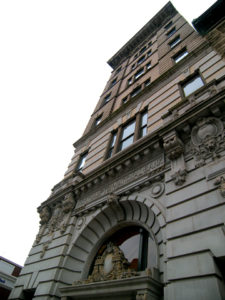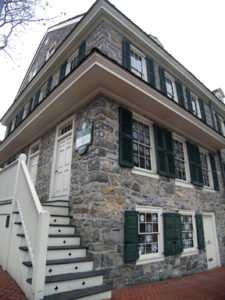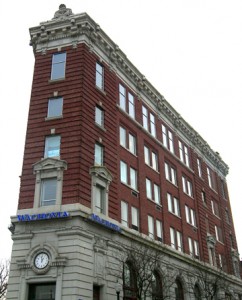Architecture In The Lehigh Valley
By Carole Gorney
 The Lehigh Valley is a veritable treasure trove of architectural styles from early German-Moravian through more than 300 years of evolution to one of today’s most modern “green” buildings.
The Lehigh Valley is a veritable treasure trove of architectural styles from early German-Moravian through more than 300 years of evolution to one of today’s most modern “green” buildings.
The early Moravians who settled in the areas near the Lehigh and Delaware rivers in the early 1700s used logs to construct their first buildings, as exemplified by the two-and-one-half story Gemeinhaus on West Church Street in Historic Bethlehem. The second building in Bethlehem, Gemeinhaus, is now a museum and one of many buildings in the Lehigh Valley that are listed on the National Register of Historic Places.
The largest collection of Germanic-style architecture is found in the Central Bethlehem Historic District, where throughout the District typical elements such as herringbone patterned doors, two-sided gambrel roofs with double slopes on each side, and distinctive jack arch windows of wedge-shaped brick can be seen.
Today, we are able to enjoy the structural history of the Lehigh Valley thanks to the efforts of many private citizens, historical societies and architectural restoration specialists.
The Easton Historic District contains some 400 buildings of architectural integrity, representing styles from Colonial to Art Deco. Colonial architecture (1752-1810), which really is a combination of European styles, is well represented. The Easton House (Bachmann) Tavern at Northampton and Second streets is the oldest building remaining in the city, and remarkably more than 70 percent of its materials are original, including the upper windows and interior. The First United Church of Christ on Third Street is another fine example of the Colonial style. The stone portion of the church was built in 1775-76, and in 1832 a brick tower was added by Thomas Walter, architect of the U. S. Capitol dome.
 The balance and symmetry of Federal architectural designs (Greek Revival and Georgian) were borrowed from the ancient Greeks and Romans, and were preferred by the federal government in the early days of the Republic. (This style is reflected in the layout and construction of Washington D.C.) There are many examples of Federal architecture in the Lehigh Valley, most notably the George Taylor Mansion, a two-story stone Georgian house on Front Street in Catasauqua built by Philadelphia carpenters in 1768 as the home of one of the signers of the Declaration of Independence.
The balance and symmetry of Federal architectural designs (Greek Revival and Georgian) were borrowed from the ancient Greeks and Romans, and were preferred by the federal government in the early days of the Republic. (This style is reflected in the layout and construction of Washington D.C.) There are many examples of Federal architecture in the Lehigh Valley, most notably the George Taylor Mansion, a two-story stone Georgian house on Front Street in Catasauqua built by Philadelphia carpenters in 1768 as the home of one of the signers of the Declaration of Independence.
The Herman Simon House (YWCA) on Third Street in Easton has personal significance for me, since it was my temporary home for two weeks when I first moved to the Lehigh Valley in 1982.
It is one of several fine examples of Eclectic and Revival architecture (1840-1910). Built at a cost of $250,000 in the early 1900s by wealthy silk baron Herman Simon, the mansion was designed in a High Renaissance French Chateau style. The stairwell features elaborately carved woodwork, and overhead is a skylight of stained glass crafted by world renowned artisans at the D’Ascenzo Studios of Philadelphia. The original Delft (Dutch tile) kitchen also remains.
The State Theatre, also in Easton, represents the Beau Arts style of architecture (combining Greek, Roman and Renaissance aspects) that was fashionable from roughly 1890-1925, especially for large buildings. What sets this style apart is its intentional Classic look—formal, balanced, grandiose and highly ornamental. Since it was originally built as a bank in 1873, the historic State Theatre building has been remodeled several times. It was rebuilt in 1910 as a vaudeville theater, and redesigned again in 1925-26 by William Lee, a prominent theater designer, in a mix of Spanish and Renaissance styles. Saved from demolition in 1981, the theater has been restored to its original opulence through an extensive restoration effort.
In the latter decades of the 1800s, the Lehigh Valley flourished as the second most important region for silk manufacturing in the nation. Local building construction also boomed in the heyday of the Industrial Revolution. South Bethlehem architect, A. W. Leh (1848-1918), contributed significantly to the distinctive architecture of the Valley in his designs of churches, school buildings and prominent residences. Among the Bethlehem buildings he designed are Broughal Middle School, the former Orr’s Department Store (Main Street Commons), and the Flat Iron Building (Wachovia Bank).
Leh favored the Romanesque architectural style, but he also excelled in Industrial design, as evidenced by the Lipps & Sutton Mill, the first silk mill built in the area, and a nationally recognized historical site that now houses the offices of the Borough of Fountain Hill.
Unlike similar structures of the time, the Lipps & Sutton Mill design contains an impressive array of highly articulated decorative features, including corner turrets with pyramid-shaped pinnacles of sheet metal, pilasters formed by recessing the brick walls of the building in a series of steps, and corbelled wall details where bricks are placed in layers so that each juts out above the one below.
In the period of Art Deco and Gothic tall buildings, the Pennsylvania Power and Light Building was built in Allentown in 1928, and as the world’s tallest building at the time, it became the model for New York City’s most famous skyscrapers. Designed by William Frederick Lamb (1883–1952), the same architect who was the principal designer of the Empire State Building, the PPL Building still dominates the Lehigh Valley skyline.
Today, we are able to enjoy the structural history of the Lehigh Valley thanks to the efforts of many private citizens, historical societies and architectural restoration specialists. The R. J. Doerr Company, an award-winning restoration firm in Williams Township, has worked on dozens of projects, including the Moravian Waterworks and the Tannery in historic Bethlehem, and Easton’s Bachmann Tavern.
 Many historical buildings in this area are distinctive for their tile work—some featuring handcrafted tiles and mosaic floors, walls and ceilings produced by the Moravian Pottery and Tile Works, founded in 1912 in Doylestown by Henry Mercer, a leader of the Arts and Crafts movement of the early 20th century. Modern tilers like Nathan Breininger of Distinctive Tile and Stone in Allentown are carrying on the tradition in the Lehigh Valley on a smaller scale, adding their own styles as architectural adornments to residences and commercial structures. Breininger, who cast the Karl Mickolas concrete sculptures in front of the Banana Factory in South Bethlehem, specializes in custom walkways, walls and stone floor work. He uses free form and classic designs as his inspiration.
Many historical buildings in this area are distinctive for their tile work—some featuring handcrafted tiles and mosaic floors, walls and ceilings produced by the Moravian Pottery and Tile Works, founded in 1912 in Doylestown by Henry Mercer, a leader of the Arts and Crafts movement of the early 20th century. Modern tilers like Nathan Breininger of Distinctive Tile and Stone in Allentown are carrying on the tradition in the Lehigh Valley on a smaller scale, adding their own styles as architectural adornments to residences and commercial structures. Breininger, who cast the Karl Mickolas concrete sculptures in front of the Banana Factory in South Bethlehem, specializes in custom walkways, walls and stone floor work. He uses free form and classic designs as his inspiration.
Finally, a survey of architecture in the Lehigh Valley would be incomplete without mentioning modern “green” initiatives, such as the new Spillman Farmer Architects office building in the Lehigh Valley Industrial Park VII. Built on one of the former Bethlehem Steel sites, it makes use of environmentally sound and energy efficient lighting and air-handling techniques, and 20 percent of the building materials were recycled. A bit of irony is the reception desk, which is constructed out of steel beams salvaged from the Bethlehem Steel structure that was demolished on the site of the new office building. A true example of today’s need to “reduce, reuse, recycle.”
Carole Gorney, a history buff and architecture enthusiast, is professor emeritus at Lehigh University, where she taught writing and public relations courses for 25 years.




